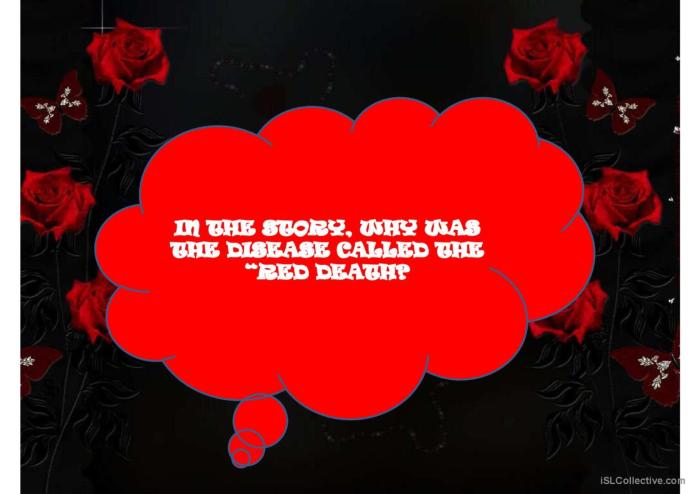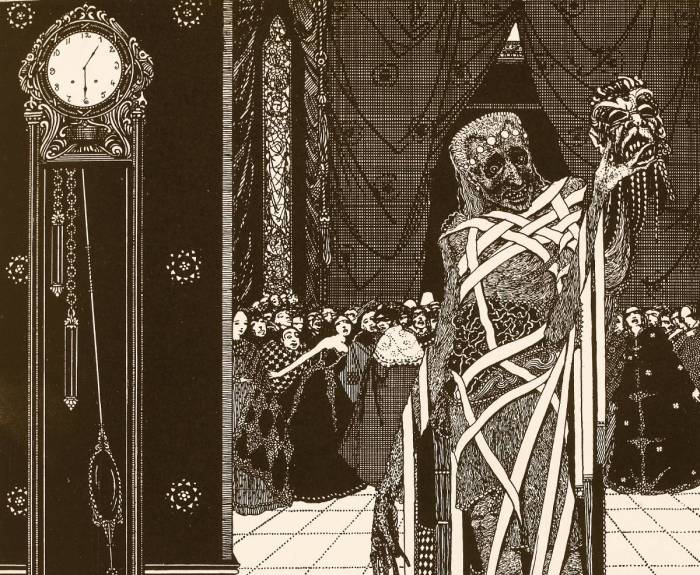The Masque of the Red Death Vocabulary Practice invites you on a captivating journey into Edgar Allan Poe’s masterpiece. Through a comprehensive analysis of key vocabulary, you’ll delve into the depths of this haunting tale, unraveling its intricate symbolism and uncovering the profound themes that resonate beyond its pages.
Vocabulary Analysis: The Masque Of The Red Death Vocabulary Practice
Vocabulary plays a crucial role in “The Masque of the Red Death” by Edgar Allan Poe. The author employs a rich and evocative vocabulary to create a vivid and unsettling atmosphere. Key vocabulary words include:
- Abominations: grotesque and horrifying creatures
- Ebony: a type of black wood, often associated with death and mourning
- Macabre: gruesome and horrific
- Phantasmagoria: a changing, dreamlike sequence of images
- Sanguine: blood-red, associated with death and violence
Poe also uses figurative language to enhance the story’s atmosphere. Similes, such as “like the notes of a death-bell” and “like the crimson stains of a plague,” create vivid sensory images that evoke a sense of dread and foreboding.
Character Analysis

Prince Prospero
Prince Prospero is the protagonist of the story. He is a wealthy and eccentric aristocrat who seeks to escape the Red Death by hosting a masquerade ball in his abbey. Prospero is arrogant and prideful, believing that he can outwit death itself.
However, his attempts to evade the inevitable prove futile.
The Red Death
The Red Death is a personification of death. It is described as a tall, skeletal figure with glowing red eyes. The Red Death represents the inevitability of death and the futility of trying to escape it. It stalks the abbey, claiming the lives of the guests one by one.
Setting and Atmosphere
The story is set in a secluded abbey during a time of plague. The abbey is described as a labyrinthine structure with seven rooms, each decorated in a different color. The rooms represent the different stages of life and the inevitability of death.
Poe uses vivid imagery and sensory details to create a sense of suspense and foreboding. The abbey is described as “a dim, vast, and antique building” with “strange, fantastic” rooms. The guests are described as “pale” and “fear-stricken,” their faces “gaunt” and “emaciated.”
Themes and Symbolism

The Inevitability of Death, The masque of the red death vocabulary practice
The central theme of “The Masque of the Red Death” is the inevitability of death. No matter how wealthy or powerful one may be, death will eventually come for them. Prospero’s attempts to escape death are futile, and he and his guests are ultimately claimed by the Red Death.
The Vanity of Human Efforts
The story also explores the vanity of human efforts. Prospero believes that he can outwit death by hosting a masquerade ball, but his efforts are ultimately in vain. The Red Death stalks the abbey, claiming the lives of the guests one by one.
Historical Context

“The Masque of the Red Death” was written in 1842, during a time of great social and economic upheaval. The story reflects the fears and anxieties of the time, including the fear of death and the fragility of human life.
The story also reflects the influence of other literary works, such as Boccaccio’s “Decameron” and Chaucer’s “Canterbury Tales.” Poe borrowed elements from these works, such as the idea of a group of people fleeing from a plague and the use of a personification of death.
Question Bank
What is the significance of vocabulary in The Masque of the Red Death?
Vocabulary plays a crucial role in creating the story’s vivid atmosphere, enhancing the characters’ motivations, and conveying the underlying themes.
How does the author use figurative language to impact the story’s atmosphere?
Figurative language, such as metaphors and similes, is employed to create a sense of suspense, foreboding, and the inevitability of death.
What is the symbolism behind the different rooms in the abbey?
Each room represents a different stage in the progression of the Red Death, symbolizing the inevitability of death and the futile attempts to escape it.
